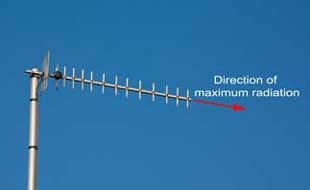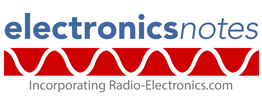Yagi Antenna Gain, Directivity & Front to Back Ratio
Yagi antenna gain is dependent upon many factors including the number of elements, spacing and several other minor factors.
Home » Antennas & Propagation » this page
Yagi antenna includes:
Yagi antenna
Yagi antenna theory & calculations
Yagi antenna gain & directivity
Yagi feed impedance & matching
The key advantages for using a Yagi antenna are the gain and directivity it provides. The gain is often the headline specification for the particular Yagi antenna.
The Yagi or Yagi-Uda antenna gain is particularly useful because it enables all the transmitted power to be directed into the area where it is required, or when used for reception, it enables the maximum signal to be received from the same area.
Coupled to this the fact that it has reduced gain in other directions means that it receives or transmits less signal in other directions thereby reducing the levels of interference.

It is worth understanding that the performance of a passive antenna (i.e. one with no active elements like transistors, etc) like the Yagi is equal for both transmit and receive, and therefore gain for transmitting will be the same as gain when receiving.
What is Yagi antenna gain
One of the key factors about a Yagi antenna is that it provides gain. However it is necessary to understand a little about what the Yagi antenna gain is.
By focussing or 'beaming" any power that is transmitted from the antenna in the required direction, it means that the signal is stronger than it would have been without the gain of the antenna.
It is worth noting that the gain for receiving and transmitting are exactly the same.
The gain is always a relative measurement. This means that the signal from the Yagi antenna has to be compared against a known standard.
There are two standards that are used. The easiest one is to use a dipole, then real measurements can be made, first with the dipole and then with the Yagi. The gain is the difference between the signals using the different antennas.
The second type of antenna is called an isotropic source. This is an imaginary antenna that radiates equally in all three planes. As the dipole has a directional pattern, it is possible to determine that the gain of a dipole is 2.1dB above that of the isotropic source in the direction of maximum radiation.
Using this it is possible to note that the gain of an antenna when compared to an isotropic source will be 2.1dB greater than that when it is compared to a dipole.
Figures of antenna gain when compared to a dipole are often designated dBd, and over an isotropic source, they are designated as dBi.
Yagi gain / beamwidth factors
There are many factors that affect the overall Yagi antenna gain. There is a link between the gain and the beamwidth. If the Yagi gain increases, then the beamwidth decreases. This can be reasoned by thinking of the available transmit power. As there is only a certain amount of power available, to create gain, power must be taken from one direction to put into the main beam.

This means that very high gain antennas are very directive. Therefore high gain and narrow beam-width sometimes have to be balanced to provide the optimum performance.
Yagi-Uda antenna gain considerations
It is sometimes tempting to want to look for the maximum amount of forward gain in an antenna design. However, this may not always be the best option as there are several considerations.
The gain of an antenna comes at a cost, and these have to be balanced against the advantages that coem from the additional gain.
There are several features of the design of a Yagi antenna that affect its gain:
- Number of elements in the Yagi: The most obvious factor that affects the Yagi antenna gain is the number of elements in the antenna. Typically a reflector is the first element added in any Yagi design as this gives the most additional gain, often around 4 to 5 dB. Directors are then added. For mid ranges of the number of directors, each director provides very roughly 1 dB of gain.
- Element spacing: The spacing can have an impact on the Yagi gain, although not as much as the number of elements. Typically a wide-spaced beam, i.e. one with a wide spacing between the elements gives more gain than one that is more compact. The most critical element positions are the reflector and first director, as their spacing governs that of any other elements that may be added.
- Antenna length: When computing the optimal positions for the various elements it has been shown that in a multi-element Yagi array, the gain is generally proportional to the length of the array. There is certain amount of latitude in the element positions.
One of the major factors controlling the Yagi antenna gain is the number of elements in the design. However the spacing between the elements also has an effect.
The overall performance of the RF antenna very many inter-related variables and as a result many early designs were not able to realise their full potential. Today computer programmes are used to optimise the designs before they are manufactured and this means that their performance is better than the early designs.
Yagi gain vs number of elements
Although there is variation between different designs and the way Yagi-Uda antennas are constructed, it is possible to place some very approximate figures for anticipated gain against the number of elements in the design. This can be a useful rule of thumb guide to the expected Yagi antenna gain.
| Approximate Yagi-Uda antenna Gain levels | |
|---|---|
| Number of elements | Approx anticipated gain dB over dipole |
| 2 | 5 |
| 3 | 7.5 |
| 4 | 8.5 |
| 5 | 9.5 |
| 6 | 10.5 |
| 7 | 11.5 |
It should be noted that these figures are only very approximate.
As an additional rule of thumb, once there are around four or five directors, each additional director adds around an extra 1dB of gain for directors up to about 15 or so directors. The figure falls with the increasing number of directors.
Yagi Front to Back ratio
One of the figures associated with the Yagi antenna gain is what is termed the front to back ratio, F/B. This is simply a ratio of the signal level in the forward direction to the reverse direction. This is normally expressed in dB.

The front to back ratio for a Yagi antenna, or any antenna for that matter, is normally expressed in decibels. Accordingly it is necessary to take the log10 for the ratio.
The front to back ratio is important in circumstances where interference or coverage in the reverse direction needs to be minimised. Unfortunately the conditions within the antenna mean that optimisation has to be undertaken for either front to back ratio, or maximum forward gain. Conditions for both features do not coincide, but the front to back ratio can normally be maximised for a small degradation of the forward gain.
The gain of a Yagi directive antenna is one of the key parameters about the operation and the physical aspects of the antenna. Forward gain needs to be balanced against a number of other factors so that the best overall performance is obtained.
That said, the Yagi offers a good level of gain for even a modest increase in weight and complexity and therefore the antenna is a good choice for many installations.
 Written by Ian Poole .
Written by Ian Poole .
Experienced electronics engineer and author.
More Antenna & Propagation Topics:
EM waves
Radio propagation
Ionospheric propagation
Ground wave
Meteor scatter
Tropospheric propagation
Antenna basics
Cubical quad
Dipole
Discone
Ferrite rod
Log periodic antenna
Parabolic reflector antenna
Phased array antennas
Vertical antennas
Yagi
Antenna grounding
Installation guidelines
TV antennas
Coax cable
Waveguide
VSWR
Antenna baluns
MIMO
Return to Antennas & Propagation menu . . .



